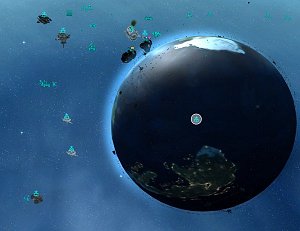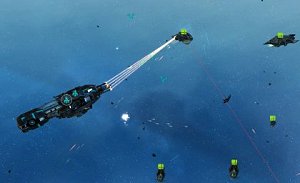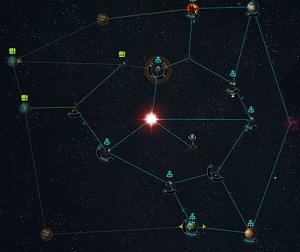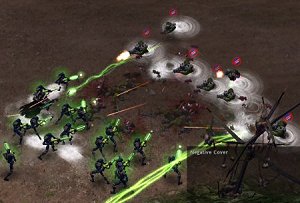 |
|
Digits & Dragons by Greg Allen |
April 2008
Miniatures and Macromanagement - Patiently Conquering the Universe
If you were to create a scale of video game intensity, you would probably put first-person
shooters and sports games on the high end and turn-based strategy and adventure games on the
other extreme. While I enjoy games on both ends of the spectrum, until recently I would have
put real-time strategy games right up with the other action games. This has all changed over the
last few months, however, as I have become immersed in a new real-time strategy game with a
space setting, Sins of a Solar Empire.
Sins is a strategy game on the grand scale - both in terms of scale and also in time and
complexity. Your control begins with the individual structures surrounding your planets and
extends all the way to maintaining a multi-solar-system empire. Taking the role of the human
Trader Emergency Coalition (TEC), the hippy-like Advent, or the mysterious Vasari, you will
seek to rid the star systems of all others.
At the base of your empire are individual planets. Each planet has a number of possible upgrades
that will raise the population limit (and therefore the taxes), provide better planetary defense, or
increase the number of building slots you have available for space structures. While tax income
happens naturally with population growth, you will also want to build mineral and crystal
extractors on the orbiting asteroids. Both minerals and crystals become more important as your
needs become more expensive and they are vital for furthering research and growing your fleet.

Everything in Sins revolves around planets
|
Now that you have some income flowing in, it's time to start spending. It is important to early
and consistently spend the resources necessary to advance your technology. Research can unlock
new ships, new structures, greater economic and military effectiveness, and a lot more. The
research tree is very cleanly laid out; just by looking at a desired tech you can see its cost, what
preceding advancements you need, and how many research stations are required to achieve it.
With your Empire getting smarter and wealthier you will quickly find that the universe is not a
friendly place. One enemy you will encounter very early on is the Pirates. The Pirates operate
off of a simple bounty principle - whatever player has the highest bounty on them gets attacked.
The pirates are rarely enough of a force to challenge an established player, but they can certainly
act as an annoyance and keep another player's fleet away from attacking yours. In addition,
players can also claim the bounty on other players by attacking them.
Ships are the new Heroes
While pirates can be a distraction, the real enemies are the other human- or computer-controlled
opponents. There are some planetary defenses that can be built but the bulk of the action comes
from your fleets of ships. Each empire has around 16 ships available to them, ranging from the
small frigates up through cruisers and the largest, the capital ships.
Frigates are usually the core of a fleet. Their roles include planet bombardment, long-range
attack, and up-close combat. If you want something a bit more solid, you can take the time and
money to research cruisers, which are even more specialized and deadly.
One cruiser, the TEC Hoshiko Robotics Cruiser, carries a complement of repair drones and
demolition bots. This makes this utility ship great not only at keeping your other ships fighting
but at getting close and causing significant damage if it needs to go on the offensive. Another
ship, the Advent Aeria Drone Host, has no weapons of its own but acts as a carrier for smaller
strike craft that can be sent out as a support in battle. Choosing the right mix of ships to make up
your fleet is vital to galactic domination.
While frigates and cruisers are nice, the real fun comes from the capital ships. The game
designers openly acknowledge Warcraft 3's heroes as an inspiration for these hero-ship units.
Capital ships are very expensive to build, but once you have one built, it continues to advance
and gain power and abilities as it gains combat experience. The difference between a level 1 and
a level 10 capital ship is huge, so although getting it destroyed is heartbreaking, it pays to get it
into the action.

Capital ships dominate in dog fights
|
The size of your fleet is limited by a unit cap which, like most other things in the game, can be
improved through research. This research comes at a cost, though, as having a larger fleet will
mean greatly higher maintenance expenses.
Running the Universe: Not a Small Task
One disappointment that many have had with Sins is the lack of a single-player campaign.
Exactly what sins these solar empires are committing or just why they are endlessly at war is only
touched on in the opening (and really bad) video. This omission would be a deal-breaker for
many if not for the fact that the rest of the game is so fantastic. (The developer, Ironclad Games,
recently announced that a campaign, as well as at least one other race, would be included in an
expansion pack.)
Rather than a campaign, there are a number of maps that can be played against computers or with
humans that range from small, seven or eight planet solar systems, all the way up to multiple-star
galaxies that take macro-management to the limits.
Handling scale is something Sins does very, very well. Although games often last for many
hours, there are rarely times when split-second decisions are necessary. This means that if you
need to go take a snack or go to the bathroom, you won't come back to find your planets laid
waste. Not only do you have time to take care of bodily necessities, you also have the time to
pay attention to your economy, your research, and your battles, all without feeling too frantic.
If you've played Supreme Commander, you know how cool a dynamically scaling zoom can be.
Being able to see the individual details of a ship and then seamlessly scale back to view the entire
galaxy is both intuitive and awesome. With just the roll of the scrollwheel you can go from
macro economic battles right down to micro-managing individual ships.

It pays to get a million-mile away view of your situation
|
I realize it probably sounds like I'm gushing about Sins, but it really is that good. I have never
played another game like it and it is my favorite RTS in years. It is slow enough for Civilization
players and still fast enough for very competitive and intense gamers. And, as if a great
packaged game isn't enough, the developers are extremely involved in the community and
continue to publish patches and new content based on player feedback.
Dawn of War: The Beautiful Details of Battle
Sins of a Solar Empire is the best strategy game I've played in a while but it certainly isn't the
only RTS I've been spending time with. The Warhammer 40,000: Dawn of War series continues
to stay relevant with solid expansions, including the latest, Soulstorm, which was recently
released. Soulstorm introduces two new races to this digital battlefield, bringing the total
available to nine.
The PC Dawn of War series is based on the fan-adored Warhammer 40,000 universe. Before it
was brought to the digital realm, Warhammer was in the domain of table-tops and home-made
terrain where metal and plastic miniatures do battle. While the table-top format is a little too
slow and detail-obsessed for me, the lore and races of this universe make for great video games.
In addition, many of the same touches that make the board game work--things like detailed color
schemes and squad-based battle--are there in Dawn of War.

Nobody ever has remorse over killing orcs
|
While Sins excels in scale and strategy, Dawn of War is up close and tactical. Deciding what
customizations to make in a squad and in what order to send in units are seemingly small
decisions that are a big deal in DoW battles. Much of the strategy in Dawn of War is centered
around critical locations - points that not only give resources but also act as outposts that you can
erect buildings around. Just staying in your base won't cut it, you've gotta get out and stake your
territory.
To make life even better for Dawn of War fans, a sequel was recently announced, and although
details are still sparse, the screenshots are jaw-dropping. Among the rumors of new features is
one that almost guarantees I'll pick it up: a multiplayer co-op campaign. There are far too few
co-op games out there, so I'm hoping Relic doesn't let us down.